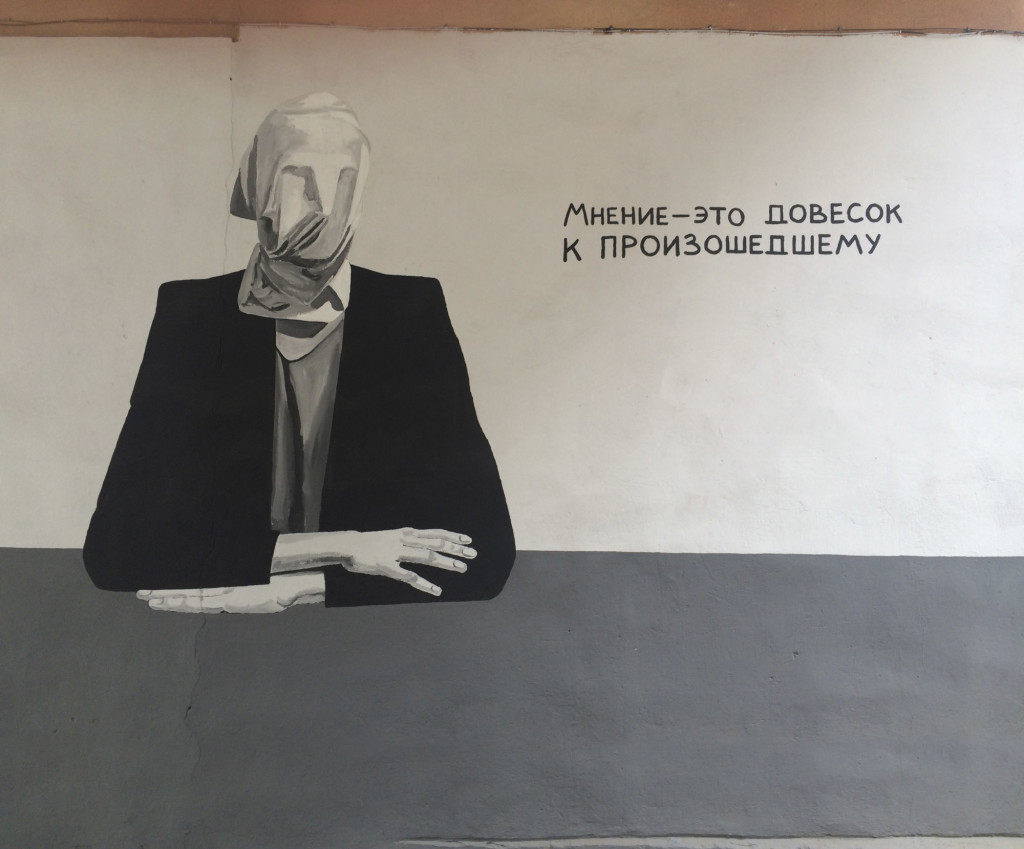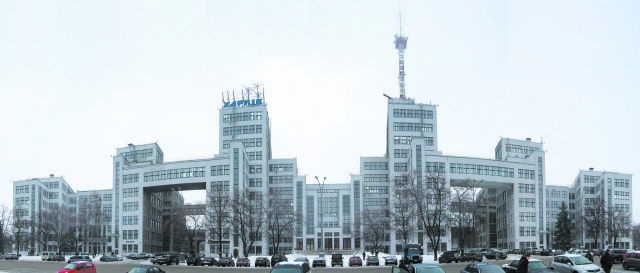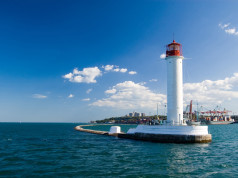My husband and I had planned to travel to Kharkiv for a long time, but somehow it never seemed to work out. From the winter, piercing winds of Odessa, even colder and harsher Kharkiv did not seem to be so attractive for a weekend trip. More so, to make a first acquaintance with the city, one did not want to ruin a first impression. In addition, while attending a concert in Odessa in December 2016, the poet Sergei Zhadan, who has been living in Kharkiv for over 10 years and loves the city, strongly cautioned us from visiting the city during winter time.
And finally all the stars came together. Our New York friend, the artist and curator, Yevgeniy Fiks, together with Ukrainian curator Larisa Babij, organized a world class exhibition in Kharkiv, called “Edenia: The City Of The future” inspired by the a Utopian novel by the Yiddish writer Kalman Sigman, which was published in Kharkov in 1918. Sigma was part of the early Yiddish literary scene in Ukraine, when Kharkiv had been the first capital of the Ukrainian Soviet Socialist Republic until 1934 when the capital was moved to Kyiv. We went to the opening of the collective exhibition in the Yermilov Art center. The center is named in honor of the famous Kharkiv artist Vasiliy Ermilov, who was a genius of design as well as a pioneer of the Ukrainian avant-garde movement. The center is a world class cultural institution and is located in the building of the national university, which in its turn is an integral part of the intellectual, cultural and spiritual history of Ukraine. Three Nobel prize laureates – the biologist Mechnikov, economist Kuznets and physicist Landau all studied and worked here.
The memoirs of Lev Landau’s wife were taken as the basis of the script for the film Dau, as the academician was called by his close friends. The film was shot in Kharkov by a character who was no less eccentric than the main character. The director Ilya Khrzhanovsky created a movie set and shot the film for no less than three years. But to say that he created a movie set is to say nothing at all. For the sake of the film, on the site of the old outdoor swimming pool on the territory of the “Dynamo” sports complex, which had been abandoned in the early 90’s, he constructed the largest shooting Pavilion in Europe with an area of 6 thousand square meters. Inside the pavilion, the fashion, vocabulary and atmosphere of the late USSR were strictly maintained with penalties for anyone who did not behave as if it were 1952. The interiors reproduced the life of that time in the smallest details. This was a mass psychology experiment as much as anything else, and people there did not play a role, but generally lived the time out for real in a theatrical manner. The shooting of the film acquired a surreal dimension as Khrzhanovsky even gave out salaries with Soviet rubles and introduced totalitarianism into the pavilion. People flew in from all parts of Europe to see the set. The release date of the film is still unknown and many people think that he may never finish the editing process.
The main thing for which the city is known is her tremendous architectural legacy. As soon as we got off the train, we immediately caught sight of unique buildings, including the station building itself and the building next to it, on the Station Square, which was a classic example of constructivism – the Main Post Office building. However, the main gem of Kharkiv constructivism is the whole ensemble of the Liberty Square, and in particular the core building of the State Industry. “House Mountain” – as it was called by Henri Barbusse, it’s height along with the first TV tower in the country measuring 108 meters. Throughout 1929-1931 it was the largest skyscraper in Europe.
In addition to the constructivism of the 1930’s, we saw buildings in the high Stalinist empire style dotting the city. The most striking example of this architectural style is a house with a spire, which is a residential house that was built in 1954 and is located on Constitution Square. This building is one of the leading attractions of the city and at the same time known as the most famous architectural decoration. Another architectural monument of Kharkiv is known as the House of Chimeras, which was made in the Art Nouveau style with elements of English Gothic included at the beginning of the twentieth century. Located at number 79 on the Chernyshevskaya street, it is not so easy to find. We did not find it straight away, and not every passer-by understood what a chimeras was or where the building was located. Prior to the revolution, the building had housed the Pokrovskaya official women’s gymnasium, and no houses the theatrical faculty of the city, and among Kharkiv citizens that we met, this designation was more widely known than just a house with chimeras.

The cultural space in Kharkov is almost superior to Kyiv and surely very far ahead of Odessa in terms of development. In addition to the Yermilov Art Center, Kharkiv also has a municipal art gallery, which has organized hundreds of projects and exhibitions over the first 20 years of it’s existence. We also visited the opening of the exhibition of two Kharkov artists, Alexei Yalovega and Yuri Vatkin, in the VovaTan gallery, that is located on the Naberezhnaya 6. The gallery is highly recommended by the way. Alexey Yalovega or Yalo, invited us to his studio, which he shared with the famous Kharkiv artist, Roman Minin, and is located on the territory of a certain disused factory. By the way, the VovaTanya gallery courtyard is wittily painted by Minin and his friend Hamlet Zinkovsky (a Ukrainian artist who is well known for his street-art work in Kharkiv and other cities).
The graffiti of Hamlet is one more reason to take a trip to Kharkiv, it is pretty great and the city is in direct completion with Kyiv as a center of street art in Ukraine.
Well, finally a little bit about bars and cafe scene. There are no less of them than are to be found in Lviv and Odessa. Aesthetically they vary from the gaucherie of the pretentious post-Soviet restaurant, to the nostalgia for Soviet times of for the Russian Imperial style, as well as variations on hipster cafe culture and mainstream burger places in the European variant. We visited a lovely establishment, the “Plasticine Crow”, a conceptual establishment which takes up many rooms in an underground space and is covered with the eponymous plasticine plastic substance beloved by generations of Soviet children. The restaurant is not so easy to find however, if you’re not a Kharkiv citizen. You have to go to the entrance of a certain apartment building on the main city drag and walk down the steps to a basement, where one can not get in without knowing the password. We also made our contribution to this institution in the form of the Odessa Review plasticine logo. I hope that we will find it on the walls the next time that we visit and that it will not get lost among the numerous masterpieces of the other visitors, each of whom makes little figures out of the soft knead material… These include a full map of Ukraine and exhortations to never forget that “Vasya was here”. And most importantly, if the waiter forgets to warn you, you will be very surprised by the menu prices listed in US dollars. Do not let them confuse you, divide everything by 0.06 – which was the exchange rate in 1974!
Regina Maryanovska- Davidzon is Managing Editor of The Odessa Review




































